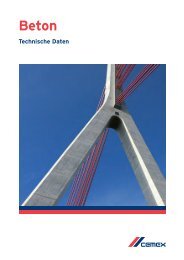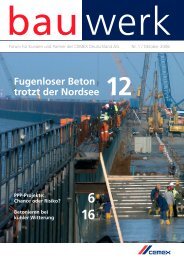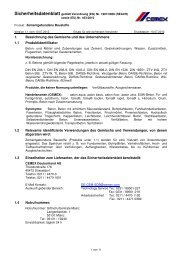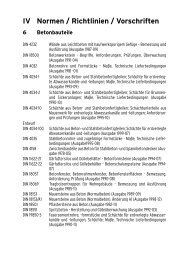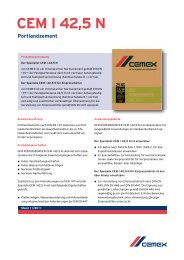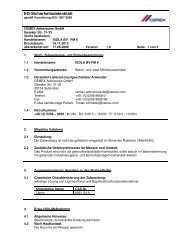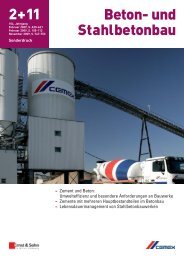building a better future - Cemex
building a better future - Cemex
building a better future - Cemex
Create successful ePaper yourself
Turn your PDF publications into a flip-book with our unique Google optimized e-Paper software.
challenges ahead:<br />
As CEMEX introduces sustainable <strong>building</strong> products and services<br />
to the market, a balance must be struck between offerings<br />
that satisfy short-term market demands, and those that will<br />
address important issues over the long term. We work to stay<br />
closely abreast of the sustainability challenges our customers<br />
face—issues such as energy efficiency and emissions reduction—to<br />
help align our products and services with foreseeable<br />
market demands.<br />
Supporting designers and developers in the first phases of<br />
project execution is another long term challenge for CEMEX.<br />
As we begin to offer a broader spectrum of <strong>building</strong> solutions<br />
and services—in addition to supplying <strong>building</strong> materials—our<br />
value propositions and customer relationships are evolving.<br />
Embracing these new business opportunities requires that we<br />
stay open minded in the development of integral construction<br />
solutions, while maintaining a focus on our company’s core<br />
mission and principles.<br />
Some features of sustainable <strong>building</strong>s imply a higher initial<br />
investment in return for savings that can be obtained over the<br />
complete life cycle of the <strong>building</strong>. Developers and construction<br />
companies are often concerned that they will not be able<br />
to command a price premium that reflects the benefit of a<br />
higher initial investment in sustainable <strong>building</strong> solutions.<br />
Therefore, CEMEX must contribute to <strong>better</strong> communicate to<br />
end users the long-term benefits of sustainable <strong>building</strong>s.<br />
(continued from previous page)<br />
the Massachusetts Institute of Technology (MIT) Concrete Sustainability<br />
Hub (CSH). Through a partnership with the Portland<br />
Cement Association and the National Ready Mixed Concrete<br />
Association in the USA, the CSH explores the life-cycle<br />
impacts of concrete when used in commercial and residential<br />
<strong>building</strong>s, roadway paving, and other infrastructure projects.<br />
a focus on life-cycle sustainability<br />
While the concept of “sustainable construction” is relatively<br />
new to the <strong>building</strong> industry, CEMEX is aggressively pursuing<br />
a leadership role in the development of products and<br />
<strong>building</strong> solutions that reduce the environmental impacts<br />
of construction projects while fostering social and economic<br />
growth. We work toward this goal by addressing the sustainability<br />
of our products from a life-cycle perspective. Our<br />
efforts fall into three main categories:<br />
1. Responsible manufacturing practices that reduce our<br />
environmental impacts and waste generation during the<br />
<strong>building</strong> materials production process.<br />
2. Developing high-performance products and technologies<br />
that address key construction challenges for <strong>building</strong>s<br />
and infrastructure projects, such as GHG emissions, energy<br />
consumption, and water use.<br />
3. Early and ongoing collaboration with customers and<br />
urban planners to help them <strong>better</strong> manage the life-cycle<br />
impacts of construction projects.<br />
Responsible manufacturing<br />
Over the years, CEMEX has made powerful and consistent<br />
improvements to its cement and aggregates manufacturing<br />
processes, including:<br />
• Reduced use of clinker in our cement production<br />
• Alternative fuel substitution at most of our manufacturing<br />
plants<br />
• Development of renewable energy sources to power our<br />
operations<br />
• Waste minimization efforts through our industrial ecology<br />
initiative<br />
• Development of CO2 measurement tools<br />
See the full details of these initiatives at www.cemex.<br />
com/SustainableDevelopment/CarbonStrategy.aspx<br />
Spotlight on the CEMEX CO2 Footprint Tool<br />
In December 2010, during COP16 in Cancun, Mexico, CEMEX<br />
unveiled the first CO2 Footprint Tool in the <strong>building</strong>materials<br />
sector and began measuring direct and indirect<br />
CO2 emissions at 29 percent of our manufacturing facilities.<br />
Within a single year, we expanded the tool’s implementation<br />
to 88 percent of our facilities, with the ability to estimate<br />
CO2 emissions at the plant, regional, or national level or<br />
companywide. On the road to a 100 percent coverage (our<br />
2015 target), we hope to more fully account for our direct<br />
and indirect CO2 emissions while also enabling clients to<br />
<strong>better</strong> estimate the CO2 embedded in their own construction<br />
projects. This approach addresses a widespread need for<br />
accountability and transparency in the construction industry<br />
around CO2 emissions, and CEMEX remains committed to<br />
providing the best available data and guidance in this effort.<br />
Spotlight on the CEMEX Industrial Ecology Initiative<br />
The goal of industrial ecology is to create closed life-cycle<br />
loops so that waste products from one industrial activity<br />
become feedstock for another—thus reducing net waste<br />
generation and demand for virgin natural resources without<br />
compromising economic activity.<br />
We already use waste products from other industries in our<br />
cement manufacturing process. For example, we use materials<br />
like fly ash and blast furnace slag, which serve as effective clinker<br />
alternatives, helping us to lower our overall CO2 emissions.<br />
To further our progress in this area, CEMEX is actively engaged<br />
in the testing of industrial ecology principles through<br />
a pilot study at its Beckum plant in Germany. Through a thorough<br />
analysis of the cement value chain and life cycle, we<br />
are investigating ways that our Beckum plant can coordinate<br />
with other industrial players to maximize CEMEX’s role in<br />
the recycling of <strong>building</strong> materials, with particular attention<br />
to aggregates recycling. We expect to share identified best<br />
practices with other cement manufacturing plants.<br />
< previous 10 next>



